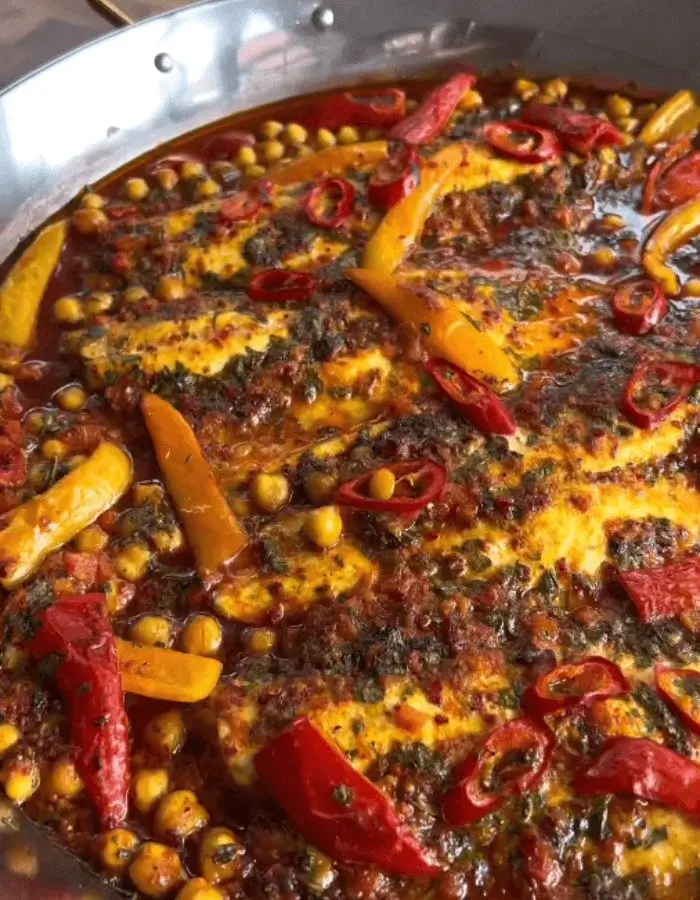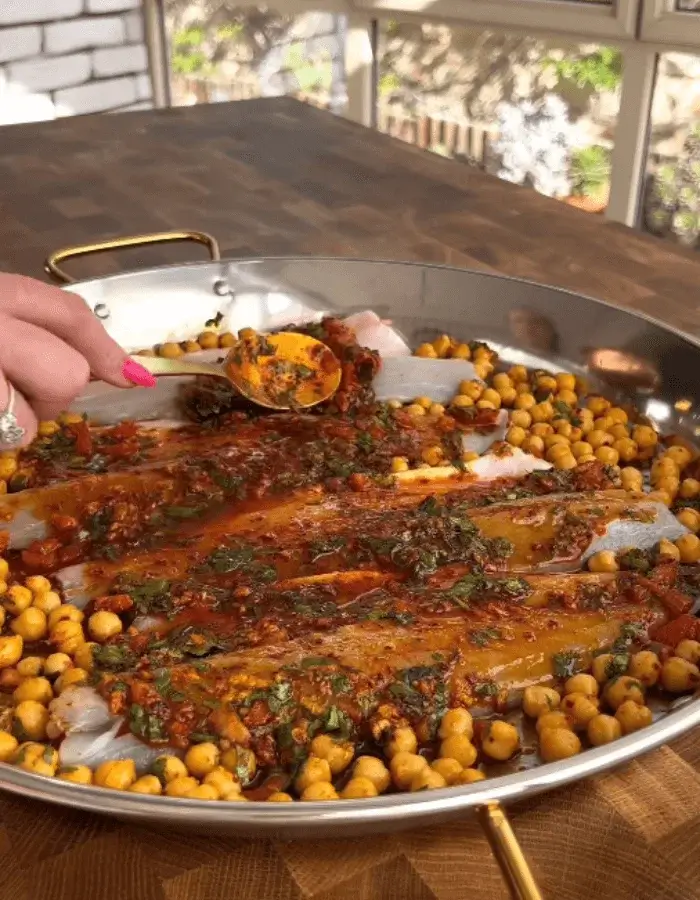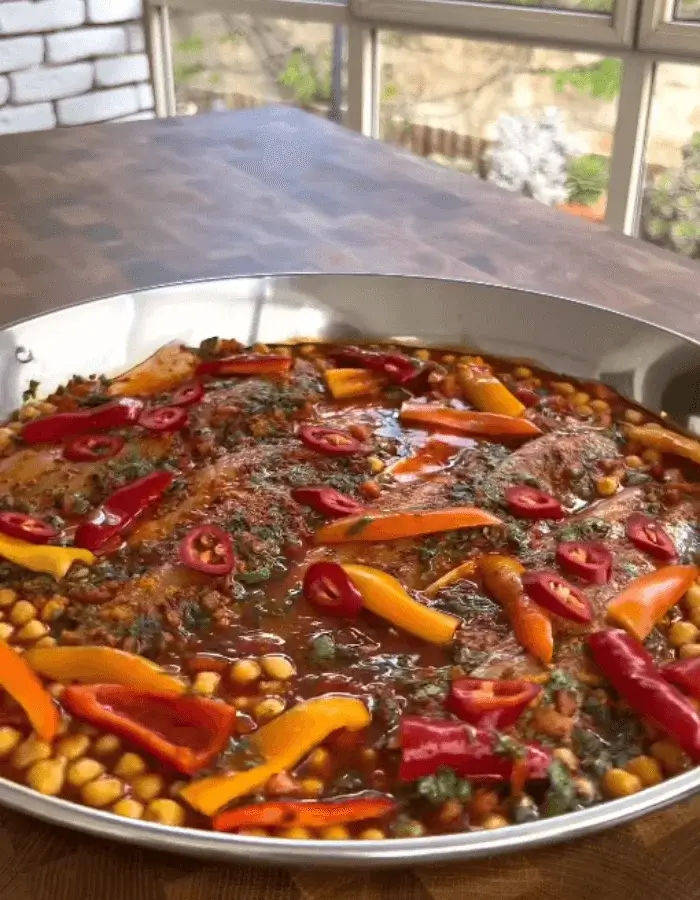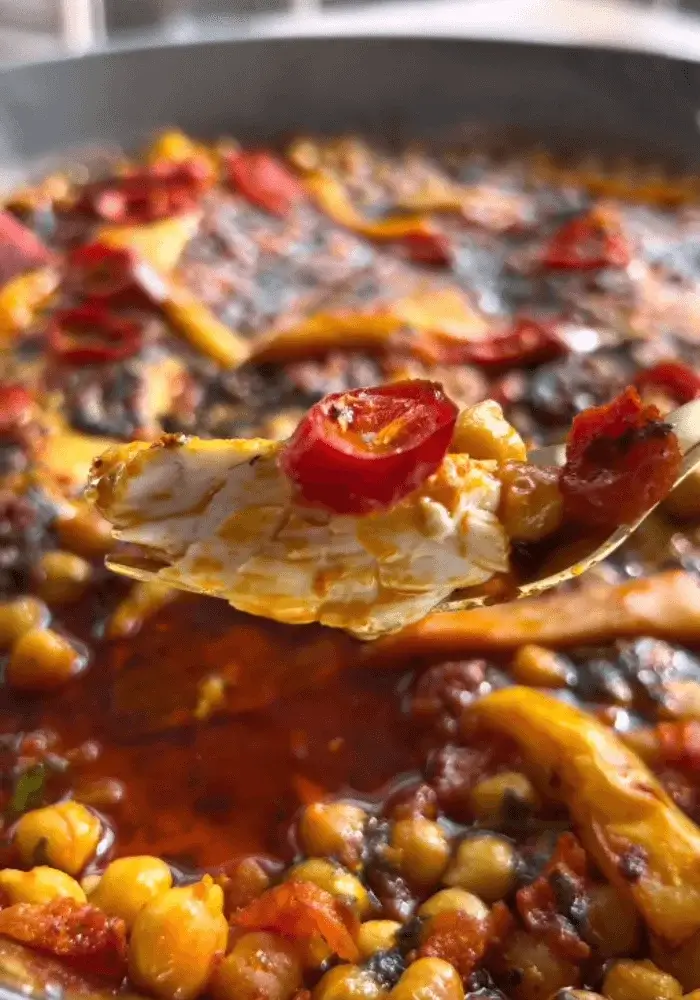Baked Sea Bass Fillets with Chickpeas and Peppers
We may earn a commission from recommended products, at no extra cost to you. See Disclosure.
- 9-by-13-inch/23-by-33 cm baking dish
- Large mixing bowl
- Chef's knife
INGREDIENTS
- 6 ounces/170 grams sea bass fillets
- 1 ½ cups/250 grams cooked chickpeas, canned, thawed from frozen, or soaked and boiled
- 8 mini sweet peppers
- 1 fresh chili pepper, optional
Sauce:
- 1 cup cilantro, finely chopped
- 1 medium tomato, about 3 ounces/85 grams, peeled and chopped
- 5 garlic cloves, crushed
- 1 tablespoon crushed sweet paprika
- 1 teaspoon sweet paprika
- 1 teaspoon ground turmeric
- A pinch of ground black pepper
- 1 teaspoon kosher salt
- ½ cup olive oil
- ½ cup water
INSTRUCTIONS
- Preheat the oven to 400°F (200°C).
- In a medium bowl, stir together the cilantro, tomato, garlic, crushed paprika, sweet paprika, turmeric, black pepper, salt, and olive oil.
- In another bowl, mix 2 tablespoons of the prepared sauce with the chickpeas. Spread the chickpeas in a 9-by-13-inch/23-by-33 cm baking dish or another shallow oven-safe pan. Lay the sea bass fillets on top of the chickpeas, skin side down if applicable. Spoon 1 tablespoon of the sauce over each fillet, spreading it evenly to coat the fish. Scatter the mini bell peppers and optional chili pepper around the fillets. Add the water to the remaining sauce, stir well, and pour it around the fish in the baking dish (avoiding the fish itself).
- Bake for 20 to 25 minutes, until the sea bass fillets are just cooked through and flake easily with a fork. For the final 5 minutes, switch the oven to broil to slightly brown the top.
- Serve hot, directly from the dish.

FAQ
Best way to ensure sea bass fillets stay moist while baking
To keep sea bass fillets moist during baking, it’s essential to avoid overcooking and to use a sauce or moisture-retaining base. In this recipe, the fillets are baked over spiced chickpeas and topped with a cilantro-tomato sauce, which helps lock in moisture. Preheating the oven to 400°F (200°C) and baking for just 20 to 25 minutes ensures the fillets cook through without drying out. Avoid pouring liquid directly over the fish, as that can wash away seasoning. Instead, surround the fillets with the sauce and vegetables to create steam and keep the sea bass fillets tender and juicy.

Can I substitute another type of fish for sea bass fillets?
Good alternatives include cod, haddock, halibut, or snapper. Choose fillets that are similar in thickness to ensure even cooking within the 20 to 25-minute bake time. Thicker fillets may require a few extra minutes, while thinner fillets should be watched carefully to avoid overcooking. Keep in mind that sea bass fillets have a mild flavor and delicate texture, so substitutions with stronger-flavored fish may alter the final taste. Regardless of the type, the fish should be fresh and firm, and the skin may be left on or removed as preferred.
Do I need to remove the skin before baking?
Removing the skin from sea bass fillets is optional and depends on personal preference. The skin can help hold the fish together while baking and may add texture if crisped under a broiler. However, in this dish, the fillets are topped with sauce and not exposed directly to heat from the top until the last few minutes, so the skin won’t become crisp. If you prefer a softer texture or want to avoid dealing with skin at the table, you can remove it before cooking. If leaving the skin on, place the sea bass fillets skin side down to help retain moisture.
How spicy is this dish if I include the chili pepper?
The spiciness of this dish is moderate and largely depends on the type and quantity of chili pepper used. Including one fresh chili pepper adds heat that balances the richness of the olive oil and the sweetness of the mini bell peppers. However, since the chili is added whole or in large pieces, the heat is not overwhelming and doesn’t permeate the sea bass fillets fully. To increase or decrease spiciness, adjust the type of chili or remove the seeds before adding. For a completely mild version, omit the chili pepper entirely without compromising the flavor profile of the dish.

What are Tinkerbell peppers?
Tinkerbell peppers are small, sweet bell peppers that come in vibrant colors like red, yellow, and orange. They have thin skins, few seeds, and a naturally sweet flavor, making them ideal for roasting whole alongside sea bass fillets. If Tinkerbell peppers are not available, you can substitute regular bell peppers. Simply cut larger bell peppers into chunks or strips to allow them to roast evenly and cook at the same rate as the fish. While the visual presentation may differ, the flavor will remain similar, and the bell peppers will still provide sweetness and balance to the savory elements.
Can I prepare the sauce for the sea bass fillets in advance?
The cilantro-garlic sauce can be made in advance and stored in the refrigerator for up to 24 hours. Preparing the sauce early allows the flavors to meld and can streamline meal prep. Mix the chopped cilantro, tomato, garlic, spices, and olive oil, then keep it in an airtight container until ready to use. Before baking the sea bass fillets, give the sauce a good stir and add water as instructed. This make-ahead step is especially useful if you’re hosting or preparing multiple dishes. Just ensure the ingredients are fresh to preserve the vibrant flavor and color of the sauce.
Can I freeze leftovers sea bass fillets?
Yes, though the texture of the sea bass fillets may change slightly upon reheating. Allow the dish to cool completely, then transfer portions to airtight containers or freezer-safe bags. Label with the date and freeze for up to one month. To reheat, thaw overnight in the refrigerator and warm gently in a covered dish in the oven at 325°F (165°C) until hot. The chickpeas will hold their texture well, but the fish may become softer. For best results, consume freshly cooked sea bass fillets, but freezing is a practical option for leftovers.
How to oven bake sea bass fillets so they stay tender and flavorful
Sea bass fillets are fully cooked when they turn opaque and flake easily with a fork. The internal temperature should reach 145°F (63°C), which you can check with an instant-read thermometer. Visually, the flesh should change from translucent to solid white and separate into moist flakes when gently pressed. Overcooking will dry out the fish, while undercooking can leave it raw in the center. Bake the fillets for 20 to 25 minutes in a preheated 400°F (200°C) oven, then broil for the last 5 minutes if desired. Keep a close eye during the broiling step to avoid burning or overcooking.

